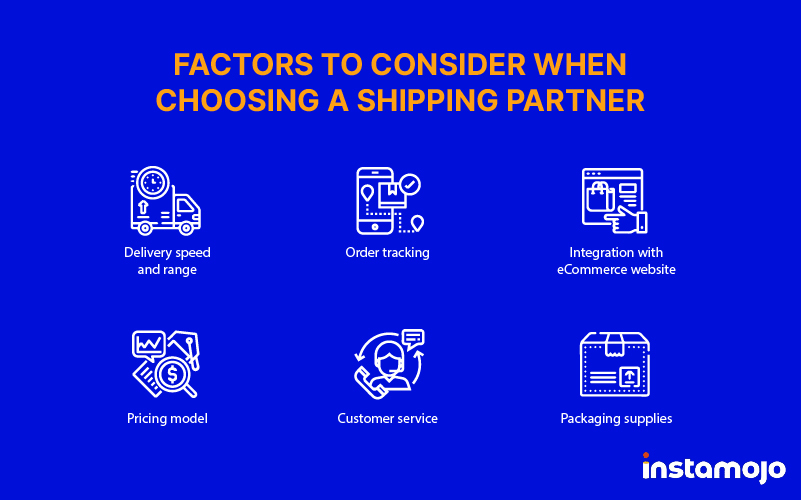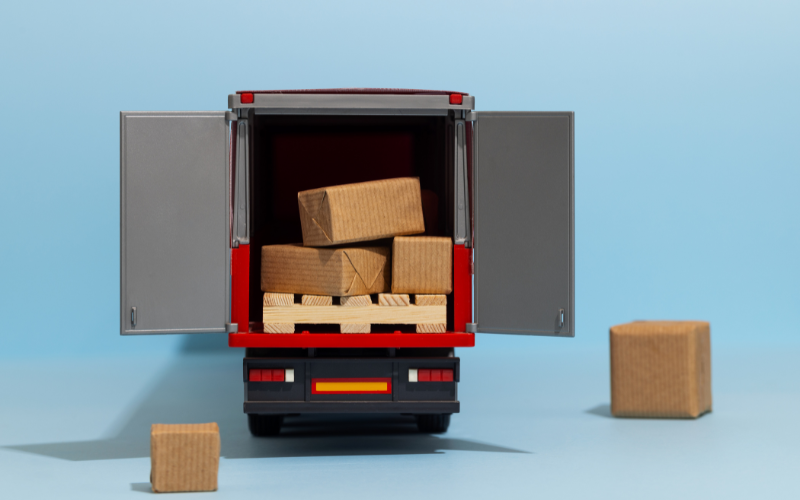Shipping is the last element in a purchase cycle, but not the least. Last impressions matter as much as first ones, if not more. This means that you could have a fantastic product and good shopping experience, but if there is a fault in delivery, your customer will be unhappy. So, in this guide, we will walk you through on setting up a good eCommerce shipping strategy for small businesses in India. You will learn about finding good shipping partners, packaging, and how Instamojo can help simplify the process.
You might know that once a small business brand proves themselves to be unreliable in terms of shipping, many customers are reluctant and even unwilling to give that same retailer a second chance.
Contents
- 1 What is eCommerce shipping?
- 2 Key factors influencing eCommerce shipping
- 3 Types of eCommerce shipping
- 4 eCommerce shipping process
- 5 Shipping policy for eCommerce website
- 6 What is the cost of shipping for eCommerce business?
- 7 Find a shipping partner
- 8 How to calculate shipping costs?
- 9 Shipping on Instamojo
- 10 Navigate the future with eCommerce shipping
What is eCommerce shipping?
eCommerce shipping is the integral process that facilitates the movement of goods purchased online from the seller to the buyer’s specified location.
This intricate procedure involves various stages, including order placement, fulfilment, packaging, labelling, and the final transportation of products.
Essentially, eCommerce shipping is the backbone of the online retail experience, shaping customer perceptions and influencing the success of eCommerce businesses.
Presently, 40% of shipments come from the top 500 to 700 postal codes, primarily representing India’s major cities. Tier 1 cities, numbering 25 to 30, contribute about 20% of the volume. The remaining 40% is distributed among Tier 2 cities and the rest of the country. There is a recent and likely accelerating shift towards Tier 2 and other areas.
Key factors influencing eCommerce shipping
The success of eCommerce shipping relies on a delicate interplay of various factors that shape the customer experience. Let’s look at some more factors:
- Customer expectations: Fast, reliable, and transparent shipping influenced by industry standards.
- Geographical considerations: Strategic planning for cost-effective and timely deliveries across diverse regions.
- Product characteristics: Packaging decisions based on size, weight, and fragility of the products.
- Regulatory compliance: Navigating local and international shipping regulations to prevent delays and legal issues.
- Technology and automation: Integration of advanced software and automation tools for efficient order processing.
Types of eCommerce shipping
The diverse options in eCommerce shipping enable businesses to meet various customer needs while managing costs and logistics.
So, let’s have a qucik look over the types of eCommerce shipping.
- Standard shipping
a. Features and characteristics:
- Traditional, cost-effective option.
- Balances cost and speed with a reasonable delivery timeframe.
b. Pros and cons:
- Pros: Economical for both businesses and customers.
- Cons: Longer delivery times compared to expedited options.
- Expedited shipping
a. Features and characteristics:
- Prioritizes faster delivery for customers seeking quick receipt.
- Involves partnerships with express courier services.
b. Pros and cons:
- Pros: Meets demand for faster deliveries, enhancing satisfaction.
- Cons: Higher shipping costs may not be viable for all products.
- Same-day/Next-day shipping
a. Features and characteristics:
- Guarantees delivery within 24 hours, catering to urgent orders.
- Often associated with local fulfilment centres.
b. Pros and cons:
- Pros: Provides unparalleled speed, meeting time-sensitive needs.
- Cons: High operational costs and logistical challenges.
- International shipping
a. Challenges and considerations:
- Involves complexities like customs, duties, and varying regulations.
- Requires careful consideration of shipping carriers with international expertise.
b. Strategies for successful international shipping:
- Utilize international fulfilment centres for localized shipping.
- Provide accurate and transparent information on customs duties and shipping times.
A point to note: According to Invespcro, in India, a whopping 80% of shoppers want same-day shipping, and 61% wish for even faster deliveries within 1-3 hours of ordering. It highlights the growing expectation for speedy order fulfillment across diverse consumer locations.
Basics of eCommerce shipping
Before you start finding courier services, you need to lay out a strategy for eCommerce shipping. This will depend upon factors like your product, business model, etc.
- Product weight: Shipping rates also depend upon the weight and size of the products. So, accurately measure and weigh the items you sell. This will help you in deciding shipping costs later.
- Packaging material and sourcing: You will be overwhelmed by the number of different packaging types available! So, you need to decide on one based on the nature of your products and costs. You also need to decide on how and where to get the materials from.
- Shipping rates: Are you going to offer free shipping, or do you want to pass on the charges to customers? There are different pricing models when it comes to shipping charges. So, you need to choose based on your business model.
Subsequently, we will discuss more on these basic elements of shipping.

Do you know that many eCommerce businesses have failed because of poor shipping strategy? Customer satisfaction highly depends on delivery and packaging experience. So, you need to get it right at the start of your business. Here are some best practises for eCommerce shipping in India for small businesses:
eCommerce shipping process
Efficient shipping processes are pivotal for customer satisfaction and business success. Here’s a quick look to key aspects:
- Order processing: Automate order confirmation and payment verification for quick processing.
- Shipping options: Offer varied shipping choices to meet customer preferences and budget constraints.
- Shipping partners and carriers: Collaborate with reliable carriers to ensure timely and secure deliveries.
- Real-time tracking: Provide customers with real-time tracking information for a transparent experience.
- Packaging strategies: Optimize packaging for cost efficiency, waste reduction, and product protection.
- Customs and duties: Stay informed on international trade regulations to manage customs processes effectively.
- Returns and exchanges: Implement seamless return processes with clear communication to build trust.
Checkout how to use auto shipment tracking on Instamojo.
Shipping policy for eCommerce website
In crafting a shipping policy for an eCommerce website in India, it is essential to provide clear and transparent guidelines to enhance the customer shopping experience.
- Specify the shipping zones covered, estimated delivery times, and associated costs.
- Address any potential delays, such as during peak seasons or due to unforeseen circumstances.
- Clearly communicate the return and exchange process, including any applicable fees or conditions.
- Offering flexibility in shipping options, such as standard, expedited, and potentially same-day delivery, can cater to diverse customer preferences.
- Highlighting any sustainability initiatives or eco-friendly packaging practices in the shipping policy can resonate positively with environmentally conscious consumers.
A well-defined shipping policy not only instills confidence in customers but also contributes to the overall success and reputation of the eCommerce business in the Indian market.
What is the cost of shipping for eCommerce business?
Shipping expenses make up a significant part of the finances of an online business.
1. Factors influencing shipping costs:
1. Shipping distance and destination:
– Longer distances and international shipments typically incur higher shipping costs.
– Destination-specific factors, such as remote locations, impact overall shipping expenses.
2. Package weight and dimensions:
– Heavier and bulkier packages contribute to increased shipping costs.
– Carriers often apply dimensional weight pricing based on package size.
3. Shipping speed and service level:
– Expedited and express shipping options come with higher costs due to faster delivery times.
– Different service levels offered by carriers contribute to varying cost structures.
2. Pricing strategies for eCommerce shipping
1. Free shipping:
– Offering free shipping can attract customers and increase conversion rates.
– Businesses may incorporate shipping costs into product prices or set minimum order thresholds.
2. Flat-rate shipping:
– Providing a consistent shipping rate for standard packages simplifies the shopping experience.
– Encourages larger orders as customers perceive added value.
3. Dynamic/real-time shipping rates:
– Calculating shipping costs in real-time based on factors like weight and destination.
– Reflects accurate costs, but transparency is crucial to avoid unexpected charges.
4. Subscription-based models:
– Offering subscription services with flat or reduced shipping rates for frequent buyers.
– Enhances customer loyalty and provides predictable revenue for the business.
5. Tiered shipping:
– Setting shipping rates based on order value or quantity.
– Encourages higher spending to qualify for reduced or free shipping.
3. Offer free shipping
Offering free shipping is a good strategy to increase sales. In fact, a survey shows that 72% of consumers cite free shipping as the reason to shop from a particular online store.
To offer free shipping to your customers, you have three main options to cover the shipping charges:
- Pay shipping charges from your margin.
- Increase price of products according to shipping costs.
- Increase product prices slightly (which means both you and customer pays).
💡Tip: You can offer free shipping on a minimum order amount. This is another good strategy to increase sales.
4. Charge flat shipping rate
Charge a rate for shipping at checkout, which will be added to the invoice separately as shipping charges. This rate will be same for all the products in your online store.
So, this model will work best if all your products are of a standard size. But, if you’re selling products of different weight and size, this may lead to loss from your side.
Find a shipping partner
There are many shipping services available in India and they have different pricing and policies. So, you need to consider which shipping partner is best for your business model.
Use the following criteria when choosing a courier company or deciding the best shipping service in India for your small business.

1. Delivery speed and range
Delivery speed, delivery range, and delivery tracking are important factors for businesses of all sizes. So if you want to select a courier company, the first thing that should be on your priority list is to look at their delivery speed. Also find out how many pin codes they deliver across.
2. Courier tracking capability
As an independent business or a DTC brand, you should know where exactly your delivery package is. This is why your courier service should be able to offer detailed tracking services. This information should also be communicated to your customers.
3. Pricing model for shipping courier
Shipping services charge on a monthly subscription basis or per order. If you are a business that receives a huge order amount, then the latter is more suitable. Some companies hide surcharges on their pricing models, so getting the rates from reputable couriers is the best way.
How to calculate shipping costs?
Shipping costs for your online store are calculated based on factors like weight of product, destination, and any additional factors such as insurance.
When calculating expenses, make sure you have included every factor before finalising the cost. Keep in mind that there may be some hidden costs apart from shipping charges. So, make sure you do your research properly to end up without a loss.
Here are some factors that contribute to shipping costs in India for your small business:
- Cost of product
- Packaging material
- Shipping costs
- GST
The sum of all this will be the shipping price you include at the end.
1. Packaging
You can choose packaging materials based on your product, durability, costs, and branding as well. Also, keep in mind that customers look forward to a beautiful unboxing experience. While a basic packaging with a brown box and bubble wrap is enough, it is always good to include something creative. So, think out of the box when it comes to packaging your products.
Did you know that good packaging drives sales too? Every year, 95% of the products fail because businesses fail to invest in packaging. (Source Forbes)
Make the packaging too good to throw away. This is a good way to make your brand memorable and stand out. Inkbliss, a calligraphy supplies business, does a good job in making their packaging one of a kind.
View this post on Instagram
The moment when customers receive their order is itself a delight. But, if the unboxing experience is also great, your customers will be over the moon! So why not invest in good packaging?
Here are a few packaging ideas to delight your customers:
- Use packaging inserts: thank you notes, discount coupons
- Packaging with brand colour scheme
- Reusable packaging materials
Are you looking for a packaging partner? Printo, a complete packaging solutions platform, designs and manufactures custom packagings in bulk that suits your brand.
You can access their services from your Instamojo dashboard and use your MojoPlus rewards points to use it.
2. Insurance
Depending on your courier partner, insurance may or may not be included in your shipping costs. If your products are valuable, it is always good to have an insurance. And most insurance policies offered by logistics services are not too expensive.
Shipping on Instamojo
Setting up costs and finding a shipping partner can be overwhelming. But, you are not alone. eCommerce shipping on Instamojo takes away a lot of the burden off your shoulders.
1. Competitive rates, discounts, and more
You can partner with a leading courier service in India through your dashboard and get the best rates. Optimise shipping costs with competitive pricing offered by our logistics partners. You can also get exclusive shipping discounts and cashback with mojoPlus benefits.
2. Easy pickup and delivery
You don’t have to worry about going to shopping centres. Just keep the package ready and the courier partner will pick it up from your doorstep. You will receive tracking updates through email. So, delivery of products will be smooth and hassle-free.
Forget tracking orders manually and shipping them one by one. You will be able to automate eCommerce shipping by syncing all your orders from a single dashboard.
Handling shipping, packaging, and delivery is a crucial part of an eCommerce business. It’s an element that is closely tied to the success of your online store. So, make sure you understand all the factors before making decisions.
To avoid struggles due to shipping issues, make smart decisions and partner with a good platform that makes your work easy. Having a single platform for shipping, tracking, and other eCommerce functions, such as order management, will save you a lot of time and effort.
One such platform to effectively handle shipping and other eCommerce needs for small businesses in India is Instamojo.

